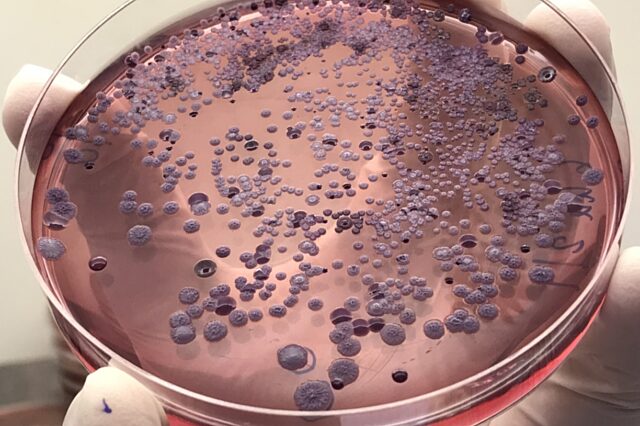UF researchers help discover novel compounds that curb melioidosis, a lethal tropical disease

For more information, please contact: Rossana Passaniti, passar@shands.ufl.edu or 352-273-8569.
University of Florida researchers have contributed to the discovery of two molecules shown to be effective at curbing Gram-negative Burkholderia bacterial infections, which cause the highly lethal tropical disease melioidosis in humans and animals.
Their study tested the molecules in novel applications using a mouse model and it also reveals how the compounds work against the bacteria. Burkholderia invade host cells, where they reproduce, and then spread rapidly from cell to cell. The UF team collaborated with colleagues at the University of California, Los Angeles and their findings published Monday in the Proceedings of the National Academy of Sciences USA.
Melioidosis is a neglected tropical disease caused by Burkholderia pseudomallei, a highly pathogenic bacteria. It is classified as a potential agent for bioterrorism because infection can result from exposure to a low dose, it is resistant to many antibiotics, and the mortality rate approaches or exceeds 50% even when it is properly diagnosed and treated.
Melioidosis is endemic in at least 79 countries, and it is estimated to cause roughly 165,000 human infections and 89,000 deaths annually – mostly in tropical and subtropical locales where the bacteria reside in the uppermost “root zone” of soil. It also occurs in water.
“The novelty of our discovery is that we found compounds that inhibit the growth of invasive Burkholderia bacteria within a host cell, and that halts its spread between cells,” said Herbert Schweizer, Ph.D., a professor of molecular genetics and microbiology in the UF College of Medicine and a member of the UF Emerging Pathogens Institute.
One compound, which the team named burkfloxacin, is a novel fluroquinolone antibiotic. This class of antibiotics is widely used against respiratory and urinary tract infections. The new analog was found to severely inhibit Burkholderia reproduction within a mouse host cell, which is a novel use.
“This is an interesting finding because although fluroquinolones are widely used, no one has previously found one that is clinically useful for treatment of human B. pseudomallei infections,” said Schweizer, an expert in antimicrobial resistance and Gram-negative bacteria. “Now that we have screened for one that has intracellular activity, maybe it can be developed into a clinically useful drug.”
The second compound, flucytosine, is a drug approved by the Food and Drug Administration for use against fungal infections. The team found that it potently blocked a secretion system that Burkholderia orchestrates to facilitate bacteria moving between host cells, which is how the melioidosis infection spreads. The type VI secretion system, known as T6SS-5, is part of a sequence of events that cause a host cell’s membrane to fuse to a second host cell and then open a portal that the bacteria use to invade. The compound disrupts this process, essentially halting spread of the infection.
“One of the real advantages of this study is the way the screening was set up by our UCLA colleagues. We knew a compound was effective against infective bacteria because we were only testing against organisms that were already inside mouse cells,” Schweizer said. “This is novel, and it is not how things are typically done because most screening studies would only test against the bacteria itself, not bacteria residing inside a living host cell.”
The novel screen enabled the researchers to identify two compounds that inhibit Burkholderia by two distinct means, burkfloxacin by causing the bacteria to die and flucytosine by disarming the bacteria’s ability to spread from cell to cell.
The two compounds were discovered out of roughly 220,000 small molecules that were screened at UCLA using a high-throughput cell-based test. Infected mouse cells were exposed to various molecules and screened for antimicrobial outcomes. The mouse cell tests were carried out with a surrogate, B. thailandensis, which has very similar infectious features to B. pseudomallei but is easier to work with because it does not readily cause disease and is not classified as a bioterrorism agent.
The UF research team provided expertise in understanding how the new compounds would fare in bacteria with existing antimicrobial resistance mechanisms. They also characterized antimicrobial activities within a mouse model to establish which compounds were disrupting Burkholderia’s infection processes.
“Melioidosis has remained understudied because it was not really on anyone’s radar in the Western world until (the bacterium) was classified as a bioterrorism agent after the anthrax attacks post 2001,” Schweizer said. “But it remains a global crisis because the bacteria are globally widespread and infections are so hard to diagnose and treat.”
Most people fall ill after inhaling the bacteria, but it can also cause disease when it is ingested or enters through a break or cut in the skin. The disease’s severity ranges from a chronic infection that resembles tuberculosis to full-blown sepsis.“These compounds deserve further consideration as candidates for drug development to treat melioidosis and similar diseases in humans,” Schweizer said.
Funding for the study came from the National Institute of Allergy and Infectious Diseases, National Institutes of Health, the U.S. Defense Threat Reduction Agency, and UF Preeminence Funds.
Link to Journal Article: https://www.pnas.org/content/early/2019/08/21/1906388116